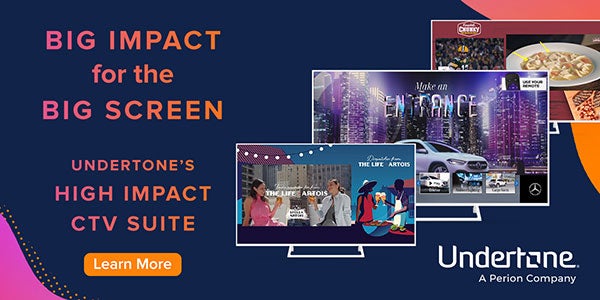By Todd Cohen, Vice President of National Video/CTV Strategy at Undertone
This article is sponsored by Undertone.
The first TV commercial aired 80 years ago. The 10-second ad cost only $9 and looked every bit the price. It included shaky camera work and five sparse words: “America runs on Bulova time.”
Advertising has changed significantly in the subsequent decades, both in how companies promote their products — and how viewers engage with that information.
But marketers face the same key challenge, even 80 years later: how to get their message to break through. Consumers see thousands of ads per day. TV ads often look similar; how will you get them to notice yours?
Fortunately, CTV advertisers can arm themselves with new tools and technologies to immediately captivate audiences, communicate key messages and even facilitate engagement.
High impact CTV to command attention
Creative innovations make CTV ads interactive, memorable and unmissable.
Marketers can use a wide range of techniques to engage audiences and highlight products in unconventional ways, including:
- Custom animations: Advertisers can capture the viewer’s attention for key messaging with creative animations. Using creative animations, advertisers can design enhanced CTV that slowly reveal a canvas with additional messaging and branding for better fluency; an automotive ad can have an animated vehicle cruising across the screen; CPG brands can use a rotating product carousel to draw attention to the commercial.
- QR codes: According to Bond, most consumers use a second screen while watching TV, and according to a recent Magnite study, 23% of CTV viewers report having made a purchase after seeing an ad. QR codes take advantage of second-screen behavior and make it even easier for viewers to act quickly when they’re most engaged. After a viewer scans an on-screen QR code within an ad, the code can lead them to a landing page or even put the product directly into their shopping cart for easier purchasing.
- Interactive ads: You have the viewer’s attention. Now what? Keep consumers engaged by enabling them to interact with your brand using their CTV remote. For example, advertisers can add a feature carousel to highlight product options or benefits alongside the ad, instead of forcing viewers away from the TV to find it on their own. Mercedes uses this innovative format to entice viewers with additional videos about their brand, which has led to a 40% lift in engagement rate over benchmarks.
Live sports alongside your commercial
These are all great ways to command attention during the ad break, but what if your commercial wasn’t in the ad pod at all? Sports reach the most passionate and engaged audience on TV, so the ideal place for your commercial might be during the game instead.
In this live CTV user experience, the sports broadcast stays live, with the commercial appearing alongside the game. It appears during a lull in the action in a double-box format, also referred to as picture-in-picture. This integration into the game broadcast is “nearly unmissable,” according to DraftKings, who also said they love the custom branded background that features their logo and key messaging.
Personalization at scale
One video can turn into hundreds of different CTV ad experiences if marketers use dynamic technology to personalize their ads based on the household viewing them. This personalization approach makes ads more interesting, relevant and engaging to viewers. For example, a retail brand can display a map to their nearest location, so every viewer sees a message that’s personalized just for them.
With high impact CTV, marketers have a wide range of innovative and compelling ways to capture a viewer’s attention across multiple formats. By pairing personalization with animations, sports in-content integrations, interactive expandable ads, unique branding, or something else entirely, high impact CTV ads deliver emotional resonance that gets noticed — and delivers results.















